The Vision of Toshiyuki Inoko, a Founder of teamLab
What exactly is teamLab, known as an art collective? To find out, we interviewed its founder and chief representative, Toshiyuki Inoko, about the background behind and the goals of the production of the group’s unique artworks.
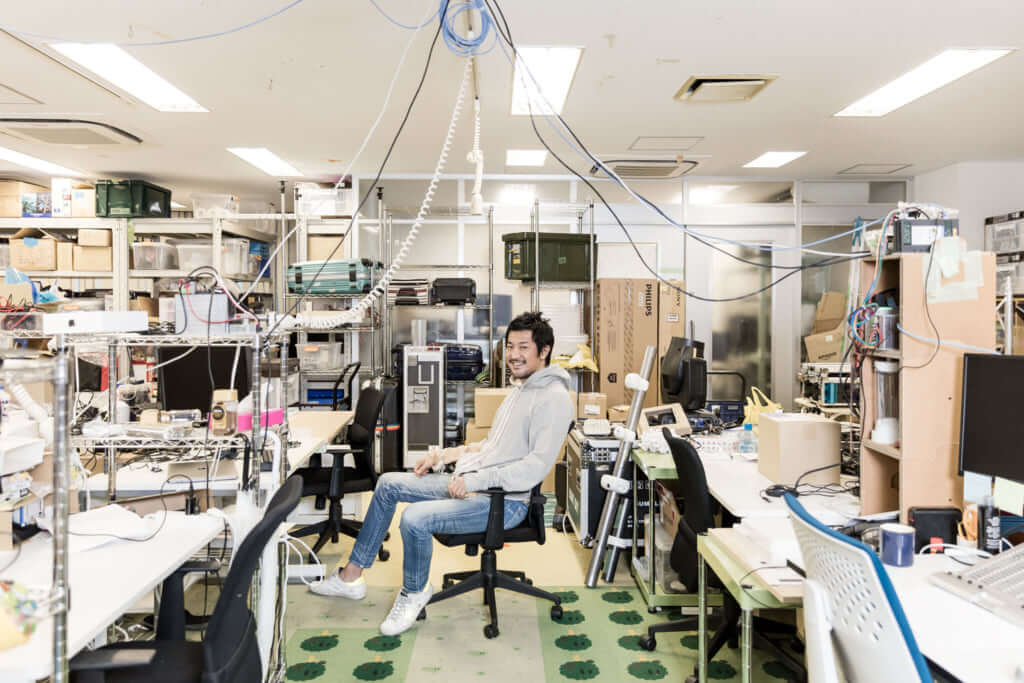
Toshiyuki Inoko, founder and chief representative of teamLab. The workshop, having become quite cramped and overcrowded owing to the increase in staff and equipment, has been relocated to new office. ©Seiichi Saito
It has now been seventeen years since teamLab was first set up in 2001. Since that time, Toshiyuki Inoko has raced forward without slackening his pace. Displaying artworks not just in ordinary art museums but also in a variety of other venues, teamLab staged the large-scale ‘teamLab Dance! Art Exhibition and Learn and Play! teamLab Future Park’ in the National Museum of Emerging Science and Innovation (Miraikan) located in Tokyo’s Odaiba area in 2014, later putting on the ‘DMM.PLANETS Art by teamLab’ exhibition in the same area in 2016. The group has garnered a lot of attention both in Japan and abroad.
Perhaps the epitome of those efforts is the MORI Building DIGITAL ART MUSEUM: teamLab Borderless exhibition (described as ‘teamLab Borderless’ below) that recently opened in Odaiba on 21 June 2018. ‘I want to make something that will be looked back upon as ‘epoch-making’ one or two decades from now’, says Inoko enthusiastically about the project, itself a kind of giant artwork stretching across a space of ten thousand square metres (almost 108,000 square feet). On the eve of its opening, we asked Inoko about the museum and teamLab’s creative activities.
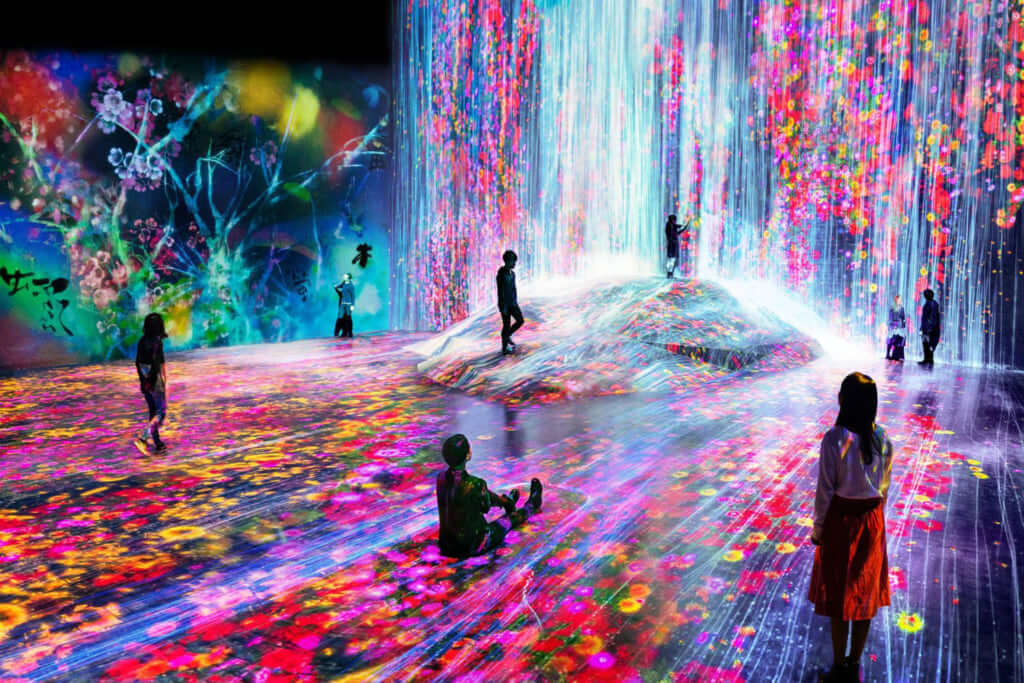
MORI Building DIGITAL ART MUSEUM: teamLab Borderless, 2018, Tokyo, Japan © teamLab
Artworks that Move and Intermingle with Visitors As Well As Other Artworks, Creating a Borderless Art Space.
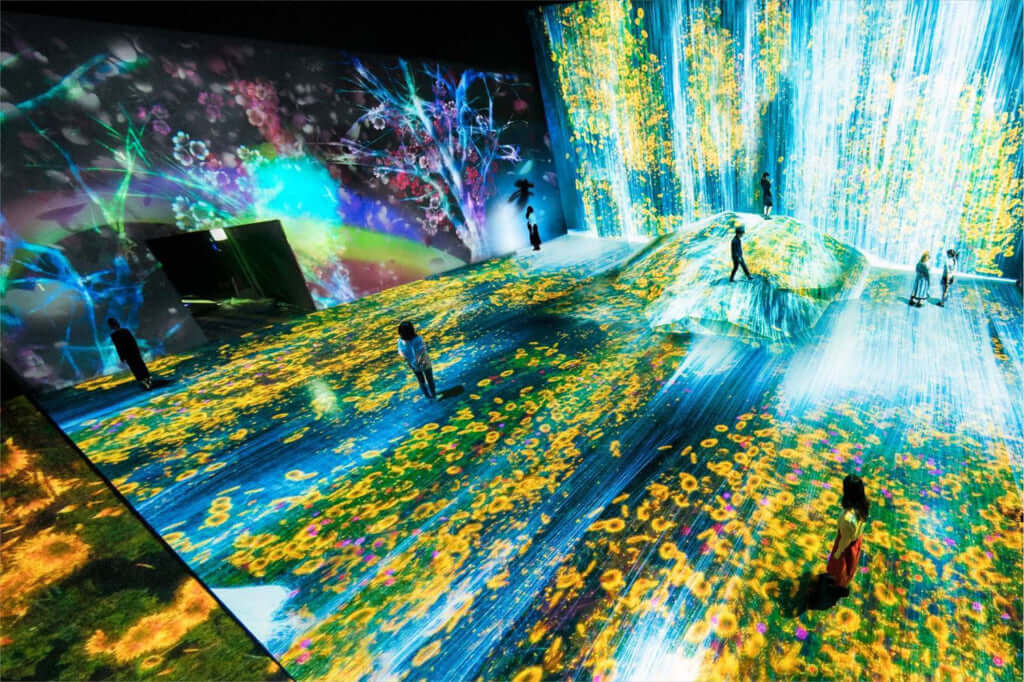
MORI Building DIGITAL ART MUSEUM: teamLab Borderless, 2018, Tokyo, Japan © teamLab
Inoko says, ‘As the word ‘Borderless’ in the exhibition’s name implies, this is a museum without borders’. Indeed, erasing borders has been a key theme of teamLab’s that is not limited to the current project.
He goes on to comment, ‘The world in which we live is full of borders. But none of those borders were there in the first place. Except for physical ones, most borders have been drawn arbitrarily by humans. For example, ‘Earth’ and ‘space’ are thought of as independent concepts, but in fact are linked to each other’.
teamLab Borderless is a space comprised of several artworks that seamlessly seem to flow into each other.
‘Normally, artworks in museums are separated by borders. In an exhibition of Van Gogh’s works, for example, a display of one of his Sunflowers alongside his The Starry Night would traditionally have the two separated by means of frames, a wall, and the like. Still, the viewer actually looks at the two in sequence or simultaneously. The viewer’s impressions and feelings about the two different paintings merge and fuse in his or her mind, creating a single world out of multiple artworks. At teamLab Borderless, the artworks jump out of the room in which they are originally located and move to another room, where they intermingle with the other works already there, and with the space they had previously filled being taken up by another artwork newly coming in. Through that act of intermingling and mixing with each other, communication results between the various works. I had long wanted to make a space like that’.
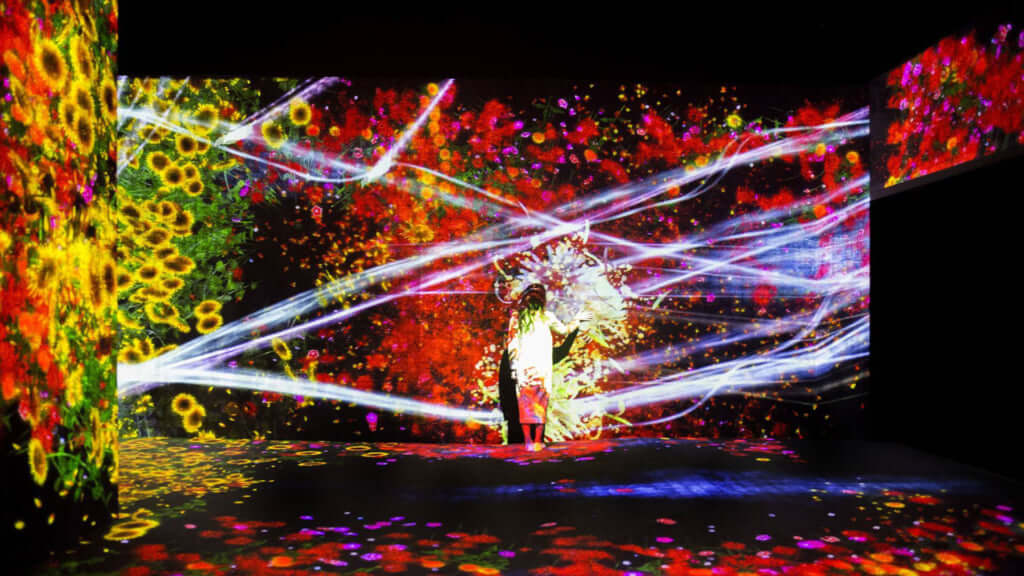
MORI Building DIGITAL ART MUSEUM: teamLab Borderless, 2018, Tokyo, Japan © teamLab
Here, the artworks establish relationships with one another, and in so doing, not only fuse together but also eliminate the borders separating the artworks from the viewers. The viewers, surrounded as they are by the art, come to feel as if they themselves are part and parcel of the works. While a few of the artworks are displayed on screens, the vast majority are projected onto walls or the floor. By eradicating the ‘frame’ of the display, the whole space transforms into an artwork that completely envelops all the viewers within.
Inoko says, ‘Through the blurring of the borders between people and artworks, the viewers themselves become part of those works, and their relationship with ‘the other’ starts to change as well. The relationships that one usually maintains in the city—separating oneself from ‘the other’—now become one stage of a continuum. We provide the opportunity for people to reflect on and rethink the borders that they had assumed existed between themselves and others’.
He continues, ‘At teamLab Borderless, for instance, one artwork shows flowers blooming on the floor when people stand still for a few seconds, with the petals dropping off once those people walk away. Previously, when such a piece had been exhibited, the viewers of the work rushed to congregate on the floor, forcing the flowers displayed there to shed all their petals. At that time, one of the viewers, noticing what had happened, said, ‘There seem to be a bit too many people here’, and beckoned some of the others to remove themselves from the space. At ordinary art museums, where the norm is to appreciate artworks silently, one would rarely speak to complete strangers in that way. In contrast, teamLab Borderless includes several pieces that are programmed to become more beautiful the greater the number of viewers, rather than just being viewed individually. In other words, the relationship one has with other viewers can be a positive thing’.
What is happening at teamLab Borderless is, in other words, an elimination of the borders between individual viewers through a unique relationship between viewer and artwork.

MORI Building DIGITAL ART MUSEUM: teamLab Borderless, 2018, Tokyo, Japan © teamLab
Throwing one’s whole body into the art causes the border established between oneself and an artwork to become ambiguous. That leads to the concept that Inoko describes as an ‘ultra-subjective space’, which has been one of the major themes that he has immersed himself in ever since teamLab’s founding.
The one-point perspective method established in Renaissance Europe is predicated on the viewer standing in one place without moving. That methodology was inherited by the camera, which succeeded in converting three-dimensional spaces into flat, two-dimensional representations (in a process known as ‘planation’) via lenses.
Inoko notes, ‘As we cannot, though, exist in the flat space created through lenses, an absolute, inviolable border results between us and it’.
In contrast, pre-modern Japanese scroll paintings contained several scenes derived from multiple perspectives that were all combined into a single painting. Events happening asynchronously were often depicted together within the same artwork. That kind of space—in which perspective is movable both spatially and temporally—is what Inoko calls an ‘ultra-subjective space’. It is an idea that derives from a change in the concept of borders.
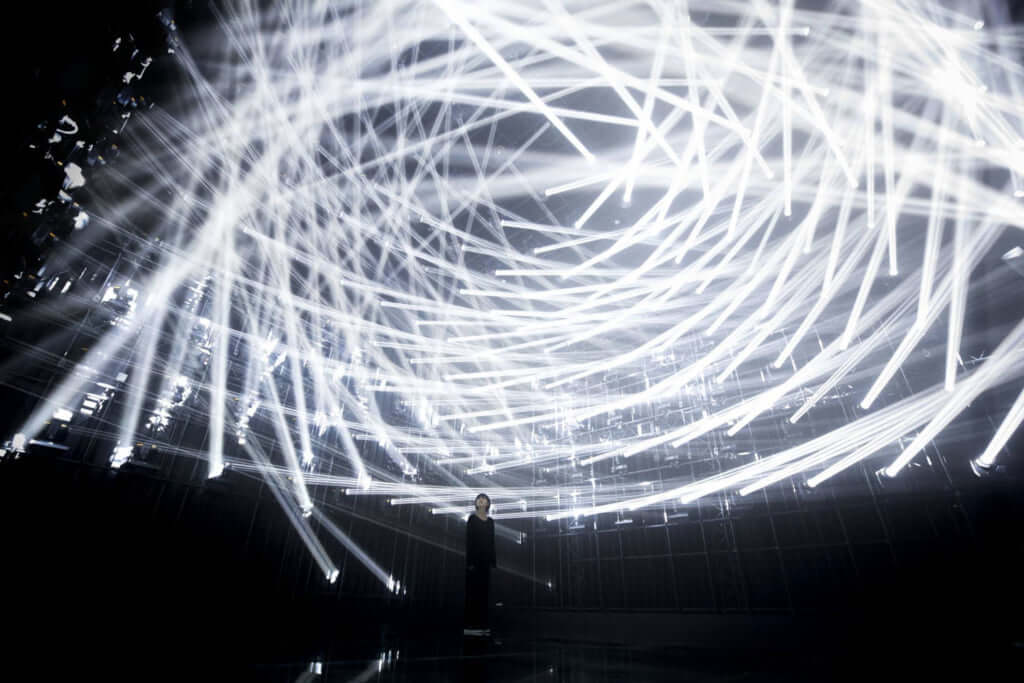
MORI Building DIGITAL ART MUSEUM: teamLab Borderless, 2018, Tokyo, Japan © teamLab
I Want Viewers to Move Their Bodies More So As to See and Think.
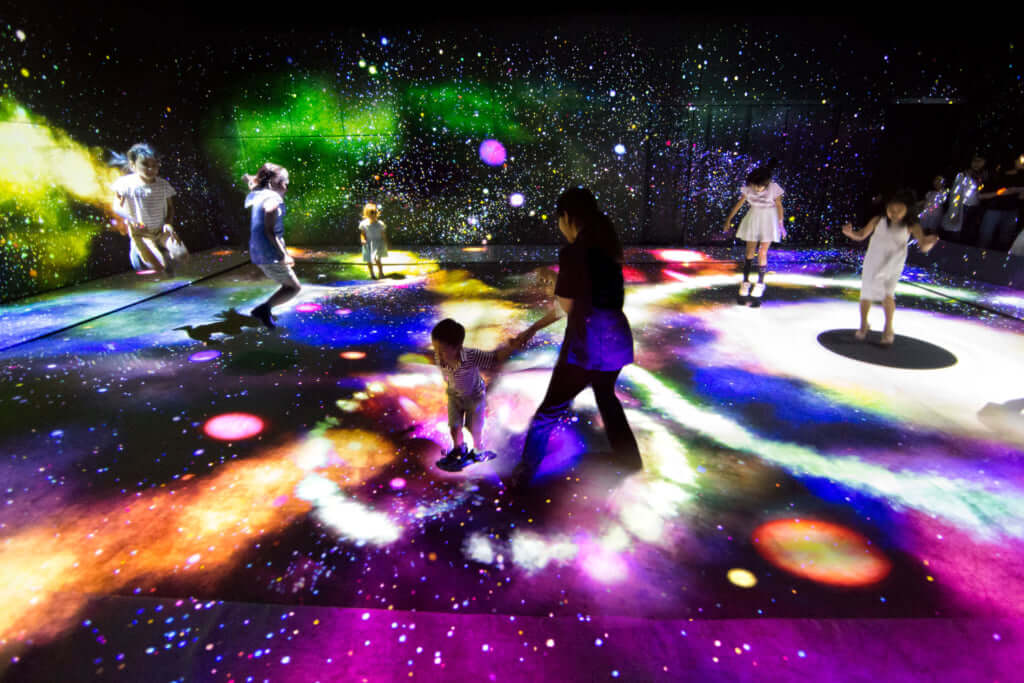
MORI Building DIGITAL ART MUSEUM: teamLab Borderless, 2018, Tokyo, Japan © teamLab
The ‘teamLab Athletics Forest’ is an important part of teamLab Borderless. The trampolines and bouldering wall may seem out of place in an art museum, but Inoko wanted to create an artwork that was literally similar to an athletic gym. It is an area to enhance one’s physical and spatial recognition abilities. He asserts that such abilities are ‘just as important as mathematics and language’.
Inoko says, ‘When a teacher tells them, ‘Sit still and listen to me closely’, students have to learn their lessons keeping their bodies in one place. Once they grow up, the same thing happens when adults look at things. However, humans evolved to be the way they are having explored the differences between high and low places, moving around so as to learn about the world and think about it. In contrast, modern urban life aims to minimise our bodies’ motion, making life in cities something tantamount to ‘throwing away our bodies’ as we go about our lives. Scientist have discovered that the hippocampus, the part of the brain that controls memory and spatial recognition abilities, grows when muscles and bones are made to move. Mice that live in complex, three-dimensional environments are said to have hippocampi with a volume fifteen percent larger than those who live in flat environments, and with 40,000 times the number of neurons. In Finland, class times at schools are kept short, with only one test given a year, and without any homework. Instead, Finnish children are said to spend their much of their time outdoors exploring and playing freely. The resulting educational level in that country is one of the best in the world. In other words, an improvement in people’s ‘basic specifications’ will allow them to continue learning for their whole lives. That’s because humans are, fundamentally, learning creatures’.
Inoko states with absolute certainty that it is important to regard things three-dimensionally; that is, to see the world and think about it in three dimensions, not two. ‘The hippocampus, researchers say, can grow new neurons even after the age of ninety. It’s not too late to start, even now’.
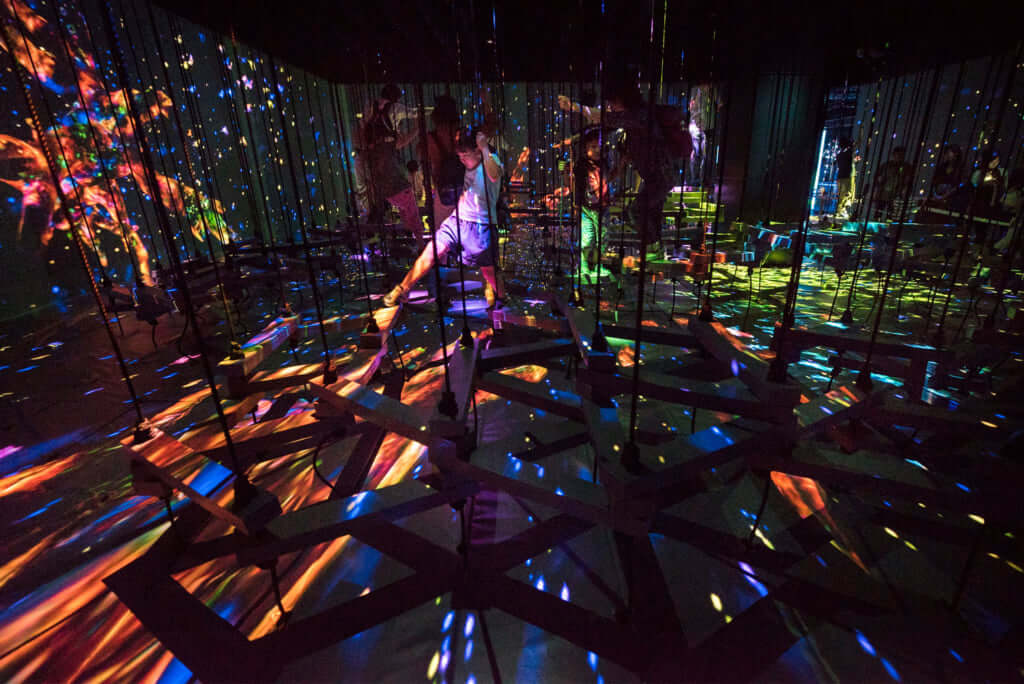
MORI Building DIGITAL ART MUSEUM: teamLab Borderless, 2018, Tokyo, Japan © teamLab
Inoko, born in Tokushima Prefecture on the island of Shikoku, used to frolic in nearby castle mountains and forests during his childhood. ‘I am fortunate to have been brought up in such a complex, multi-layered place’, he says, looking back.
Perhaps thanks to the influence of his formative years, much of what inspires Inoko seems to lead back to the key word of ‘nature’. He comments, ‘The terraced fields of Oita Prefecture in Japan, along with Angkor Wat in Cambodia, are some examples of what has made me interested in the connection between people and nature. Nature has come back to take over some of the manmade temples at Angkor Wat, while the landscapes of upland valleys and cultivated lower slopes in Japan are places where the boundaries between nature and people have come to be blurred. Such comfortable sorts of spaces, existing in the continuum between humans and nature, develop out of painstaking human actions conducted over many years. That’s because neither can we control nature, nor make something like it if only we had the money’.
The abovementioned teamLab Borderless artwork, where flowers and humans encounter and interact with one another, was inspired by that idea. ‘Humans cannot stand in one place forever. Just like nature, we are not something that can be controlled. Still, the simple relationship, in which humans stop to make flowers bloom and move to make petals to fall, creates a place that is both palpably and viscerally comfortable for us.
We humans, originally part of nature, cannot stop moving as long as we live. In line with that, teamLab’s artworks also move continually.
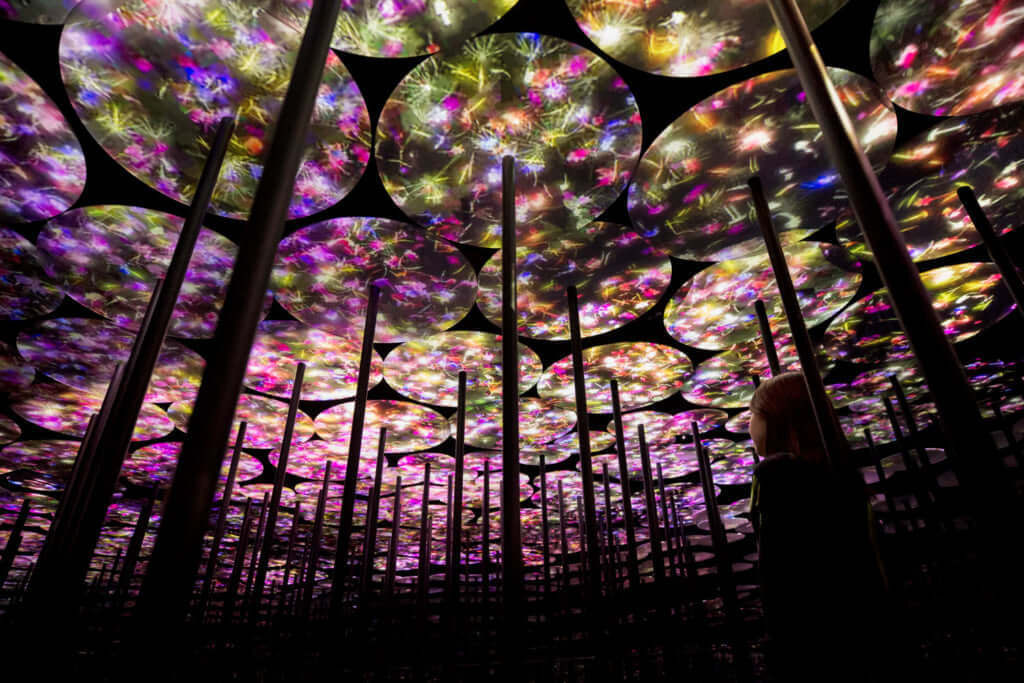
MORI Building DIGITAL ART MUSEUM: teamLab Borderless, 2018, Tokyo, Japan © teamLab
In that way, the production of those works, while revolving around Inoko’s ideas as an individual, are, as the name ‘teamLab’ suggests, carried out collectively by a team.
He says, ‘The artworks that teamLab creates cannot be made by just one person alone. Although our members all have their own specialties, the way that they conduct their teamwork also differs from traditional ways of doing things collectively. Previously, with products such as cars, it was possible to cleanly separate the different areas, with engineers making the car’s engine, designers thinking about the car’s shape, and so forth. That is to say, the domains of ‘creation’ and ‘technology’ could be cleanly delineated from each other. In contrast, it is difficult to do so with the processes involved in making new digital artworks. With products such as the iPhone, for example, one must think about not just about the shape but also the OS at the same time. For teamLab’s creations as well, it’s more rational if everybody cooperates. That’s the way the world works now, and it’s how I want to keep on living into the future’.
When Inoko founded teamLab in 2001, the act of creation was regarded as something with an individual signature’s attached; entities such as teamLab, with a group’s signature attached, simply did not exist elsewhere. The climate of the times was one in which only such expressions as ‘made by Mr X, the architect’ or ‘made by Ms Y, the designer’ were recognised.
Inoko says, ‘I founded teamLab with the intention of creating a team; namely, an experimental place of ‘collective creation’, in which I could insert myself. As for the name of the artist [appended to the artworks], moreover, it was to be a veritable ‘team laboratory’, a place of experimentation. The kind of people whom I want to come here are those who believe in the importance of a repeated process of collective experimentation for the purpose of creation. In addition, I want to develop new frontiers of beauty that do not fit easily into the existing definitions of value, such as ‘looking cool’ or ‘looking uncool’. My long-cherished ambition has been for our artworks to change viewers’ values and/or behaviour.
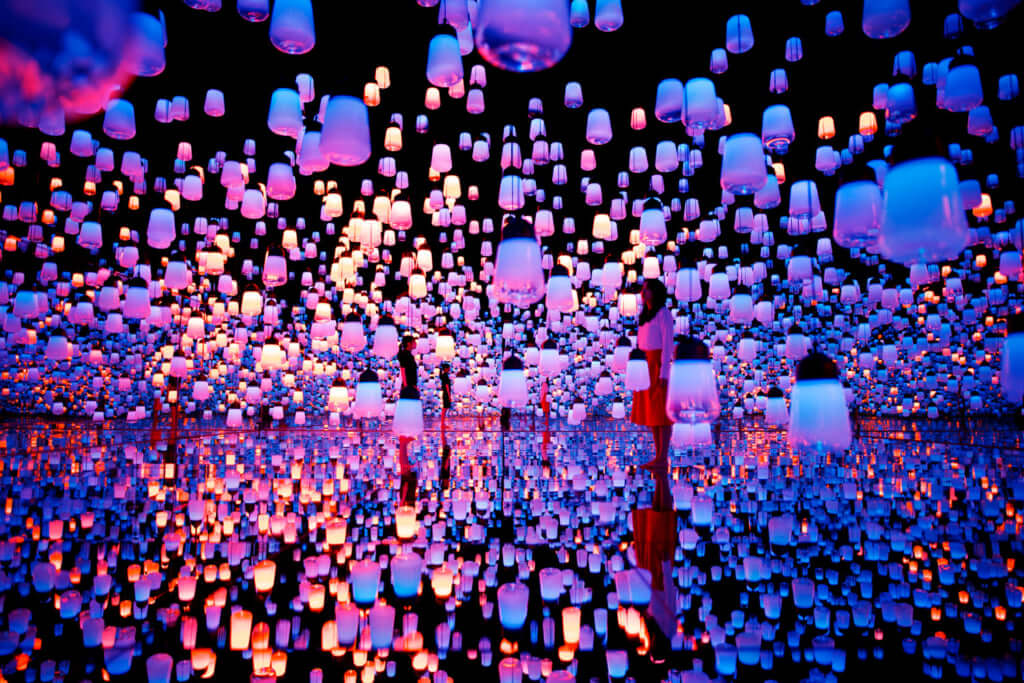
MORI Building DIGITAL ART MUSEUM: teamLab Borderless, 2018, Tokyo, Japan © teamLab
Toshiyuki Inoko
Founder, teamLab
Born in 1977 in Tokushima, Japan, Inoko founded teamLab in 2001 at the same time he graduated from the Department of Mathematical Engineering and Information Physics, School of Engineering, the University of Tokyo. He attended the University of Tokyo Graduate School of Interdisciplinary Information Studies before leaving in 2004 and studied statistics at a college and natural language processing and art at a graduate school.
TRENDING
-
A House from the Taisho Era Reveals Its Secrets
While visiting an abandoned building, Hamish Campbell discovered photographs the owner had taken of the place in the 1920s.

-
The Taboo-Breaking Erotica of Toshio Saeki
The master of the 1970s Japanese avant-garde reimagined his most iconic artworks for a limited box set with silkscreen artist Fumie Taniyama.

-
With Meisa Fujishiro, Tokyo's Nudes Stand Tall
In the series 'Sketches of Tokyo', the photographer revisits the genre by bringing it face to face with the capital's architecture.

-
Masahisa Fukase's Family Portraits
In his series ‘Family’, the photographer compiles surprising photos in which he questions death, the inescapable.

-
Hajime Sorayama's Futuristic Eroticism
The illustrator is the pioneer for a form of hyperrealism that combines sensuality and technology and depicts sexualised robots.





